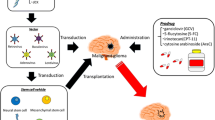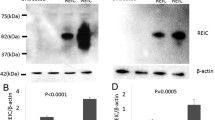Abstract
A suicide gene can convert nontoxic prodrugs into toxic products to kill tumor cells. In this study, our aim was to transfect lentivirus-mediated CD/TK fusion gene into Wistar rat’s neural stem cells (NSC) and then implant the NSC into a C6 glioma model to observe a C6 glioma growth inhibition effect. Primary NSC and stable transfection CD/TK fusion gene cell lines were established. To observe the tumor size and rat survival period in different groups, C6 glioma cell apoptosis and cell viability rate were applied to analyze the tumor inhibition effect of the neural stem cells’ transfected CD/TK fusion gene. C6 cell viability showed that CDglyTK-NSC + GCV/5-Fc (group 1) was lower than CDglyTK-NSC (group 2), NSC + GCV/5-Fc (group 3), and control (group 4) from day 2 (p < 0.05), and the apoptosis rate was higher in group 1 compared with that of other groups (50.6 %, p < 0.05) either in vitro or in vivo (35.47 %, p < 0.05); both cell viability and apoptosis had no significance in the other three groups. In vivo, tumor size in group 1 was 7.76 ± 1.37 mm3, which is smaller than the others (group2 27.28 ± 4.11 mm3, group3 27.94 ± 2.08 and 28.61 ± 2.97 mm3; p < 0.05). The other groups’ tumor size was not significant (p > 0.05). Survival time of rats treated with CDglyTK-NSC + GCV/5-Fc (group 1) was significantly longer than that of the other groups (p < 0.05; group 1 48.86 ± 1.97, group 2 28.67 ± 3.75, group 3 31.5 ± 1.27, group 4 29.3 ± 1.33). We also showed that the transfected C6 cells had a migratory capacity toward gliomas in vivo. Transfected CD/TK fusion gene neural stem cells combined with propyl–guanosine and 5-flucytosine double prodrug significantly inhibit the development of glioma.







Similar content being viewed by others
References
Michotte A, Neyns B, Chaskis C, Sadones J, In ’t Veld P. Neuropathological and molecular aspects of low-grade and high-grade gliomas. Acta Neurol Belg. 2004;104(4):148–53.
Zhao D, Najbauer J, Garcia E, et al. Neural stem cell tropism to glioma: critical role of tumor hypoxia. Mol Cancer Res MCR. 2008;6(12):1819–29.
Chang DY, Yoo SW, Hong Y, Kim S, Kim SJ, Yoon SH, Cho KG, Paek SH, Lee YD, Kim SS, Suh-Kim H. The growth of brain tumors can be suppressed by multiple transplantation of mesenchymal stem cells expressing cytosine deaminase. Int J Cancer. 2010;127:1975–83.
Chang JW, Lee H, Kim E, Lee Y, Chung SS, Kim JH. Combined antitumor effects of an adenoviral cytosine deaminase/thymidine kinase fusion gene in rat C6 glioma. Neurosurgery. 2000;47(4):931–8. discussion 938-939.
Jia W, Mei L, Wang Y, Liu L, Che G. Double suicide genes selectively kill human umbilical vein endothelial cells. Virol J. 2011;8(1):74.
Kim SK, Kim SU, Park IH, et al. Human neural stem cells target experimental intracranial medulloblastoma and deliver a therapeutic gene leading to tumor regression. Clin Cancer Res. 2006;12(18):5550–6.
Khan Z, Knecht W, Willer M, et al. Plant thymidine kinase 1: a novel efficient suicide gene for malignant glioma therapy. Neuro Oncol. 2010;12(6):549–58.
Li S, Gao Y, Pu K, Ma L, Song X, Liu Y. All-trans retinoic acid enhances bystander effect of suicide-gene therapy against medulloblastomas. Neurosci Lett. 2011;503(2):115–9.
Zhang JX, Kang CS, Shi L, Zhao P, Liu N, You YP. Use of thymidine kinase gene-modified endothelial progenitor cells as a vector targeting angiogenesis in glioma gene therapy. Oncology. 2010;78(2):94–102.
Huang Q, Pu P, Xia Z, You Y. Exogenous wt-p53 enhances the antitumor effect of HSV-TK/GCV on C6 glioma cells. J Neurooncol. 2007;82(3):239–48.
Ito S, Natsume A, Shimato S, et al. Human neural stem cells transduced with IFN-beta and cytosine deaminase genes intensify bystander effect in experimental glioma. Cancer Gene Ther. 2010;17(5):299–306.
Lee DH, Ahn Y, Kim SU, et al. Targeting rat brainstem glioma using human neural stem cells and human mesenchymal stem cells. Clin Cancer Res. 2009;15(15):4925–34.
Shimato S, Natsume A, Takeuchi H, et al. Human neural stem cells target and deliver therapeutic gene to experimental leptomeningeal medulloblastoma. Gene Ther. 2007;14(15):1132–42.
Luo XR, Li JS, Niu Y, Miao L. Targeted killing effects of double CD and TK suicide genes controlled by survivin promoter on gastric cancer cell. Mol Biol Rep. 2011;38(2):1201–7.
Lee SJ, Kim Y, Jo MY, et al. Combined treatment of tumor-tropic human neural stem cells containing the CD suicide gene effectively targets brain tumors provoking a mild immune response. Oncol Rep. 2011;25(1):63–8.
Imitola J, Raddassi K, Park KI, et al. Directed migration of neural stem cells to sites of CNS injury by the stromal cell-derived factor 1alpha/CXC chemokine receptor 4 pathway. Proc Natl Acad Sci U S A. 2004;101(52):18117–22.
Kendall SE, Najbauer J, Johnston HF, et al. Neural stem cell targeting of glioma is dependent on phosphoinositide 3-kinase signaling. Stem Cells. 2008;26(6):1575–86.
Schmidt NO, Przylecki W, Yang W, et al. Brain tumor tropism of transplanted human neural stem cells is induced by vascular endothelial growth factor. Neoplasia. 2005;7(6):623–9.
Guan S, Zhang XL, Ge D, Liu TQ, Ma XH, Cui ZF. Protocatechuic acid promotes the neuronal differentiation and facilitates survival of phenotypes differentiated from cultured neural stem and progenitor cells. Eur J Pharmacol. 2011;670(2–3):471–8.
Erlandsson A, Enarsson M, Forsberg-Nilsson K. Immature neurons from CNS stem cells proliferate in response to platelet-derived growth factor. J Neurosci. 2001;21(10):3483–91.
You Y, Geng X, Zhao P, et al. Evaluation of combination gene therapy with PTEN and antisense hTERT for malignant glioma in vitro and xenografts. Cell Mol Life Sci. 2007;64(5):621–31.
Zhang Y, Wang CW, Wang ZG, et al. Construction of double suicide genes system controlled by MDR1 promoter with targeted expression in drug-resistant glioma cells. J Neurooncol. 2008;86(1):3–11.
Ma J, Li M, Mei L, et al. Double suicide genes driven by kinase domain insert containing receptor promoter selectively kill human lung cancer cells. Genet Vaccines and Therapy. 2011;9:6.
Wu DH, Liu L, Chen LH. Antitumor effects and radiosensitization of cytosine deaminase and thymidine kinase fusion suicide gene on colorectal carcinoma cells. World J Gastroenterol. 2005;11(20):3051–5.
Aboody KS, Brown A, Rainov NG, et al. Neural stem cells display extensive tropism for pathology in adult brain: evidence from intracranial gliomas. Proc Natl Acad Sci U S A. 2000;97(23):12846–51.
Kim SK, Cargioli TG, Machluf M, et al. PEX-producing human neural stem cells inhibit tumor growth in a mouse glioma model. Clin Cancer Res. 2005;11(16):5965–70.
Sun L, Lee J, Fine HA. Neuronally expressed stem cell factor induces neural stem cell migration to areas of brain injury. J Clin Invest. 2004;113(9):1364–74.
Ehtesham M, Yuan X, Kabos P, et al. Glioma tropic neural stem cells consist of astrocytic precursors and their migratory capacity is mediated by CXCR4. Neoplasia. 2004;6(3):287–93.
Goldman S. Stem and progenitor cell-based therapy of the human central nervous system. Nat Biotechnol. 2005;23(7):862–71.
Conflicts of interest
The authors declare that they have no conflict of interest.
Author information
Authors and Affiliations
Corresponding author
Additional information
Jian Niu and Chunyang Xing contributed equally to this work.
Rights and permissions
About this article
Cite this article
Niu, J., Xing, C., Yan, C. et al. Lentivirus-mediated CD/TK fusion gene transfection neural stem cell therapy for C6 glioblastoma. Tumor Biol. 34, 3731–3741 (2013). https://doi.org/10.1007/s13277-013-0957-y
Received:
Accepted:
Published:
Issue Date:
DOI: https://doi.org/10.1007/s13277-013-0957-y




